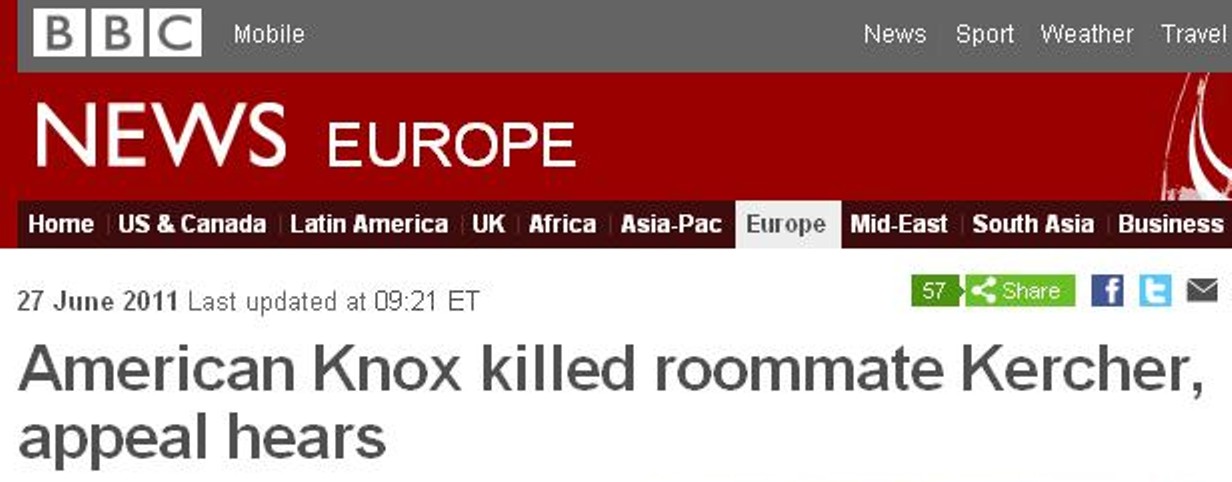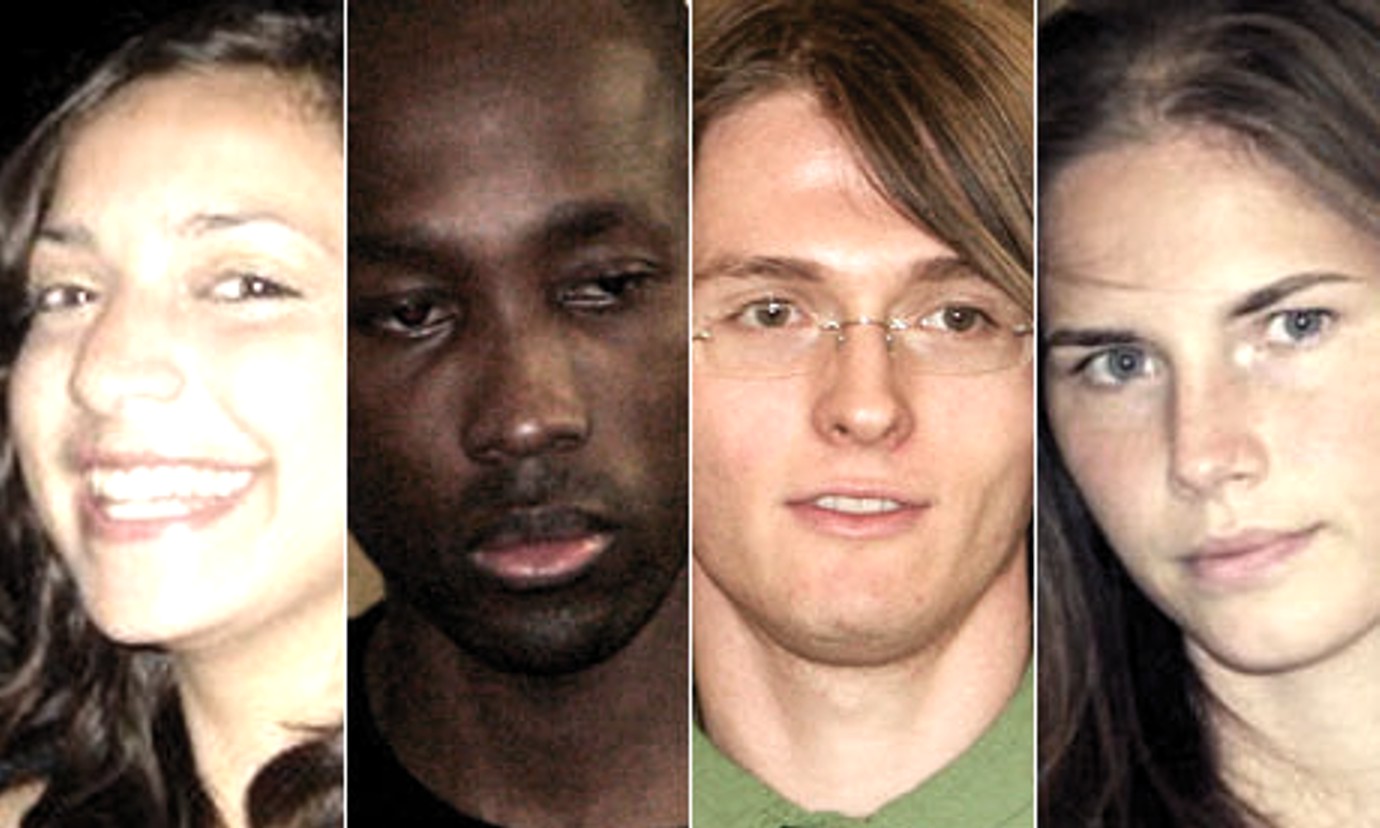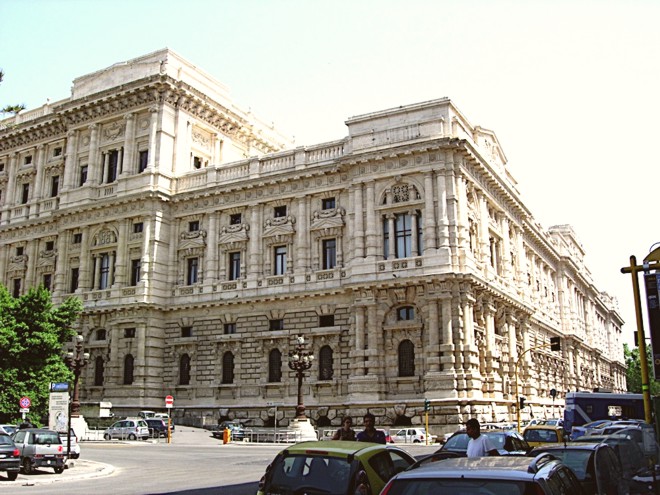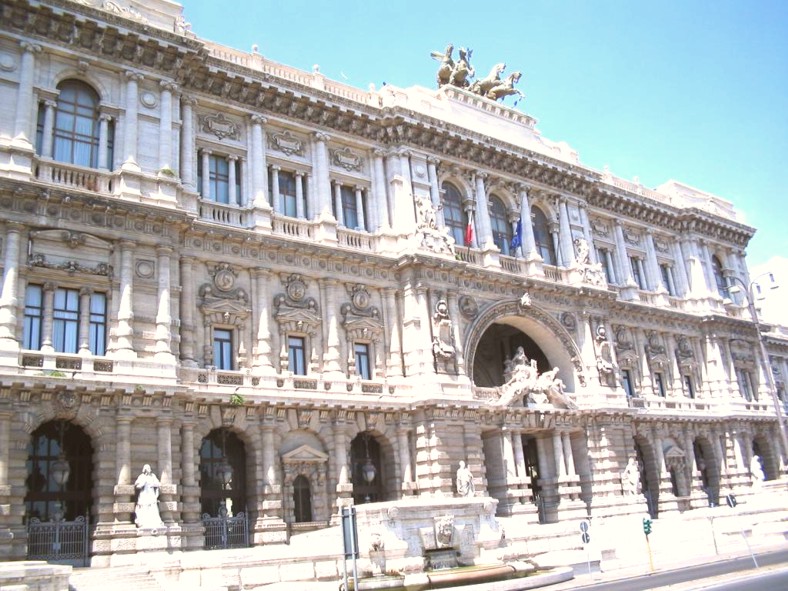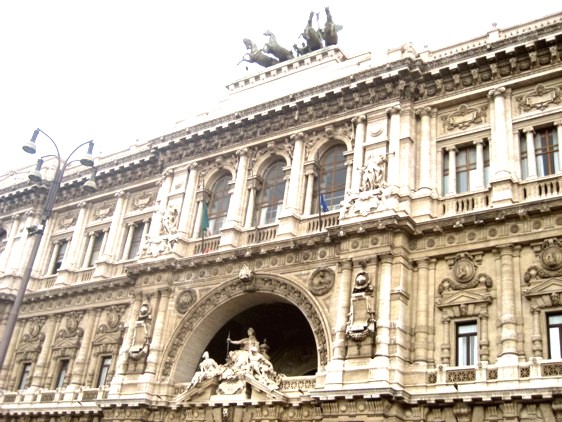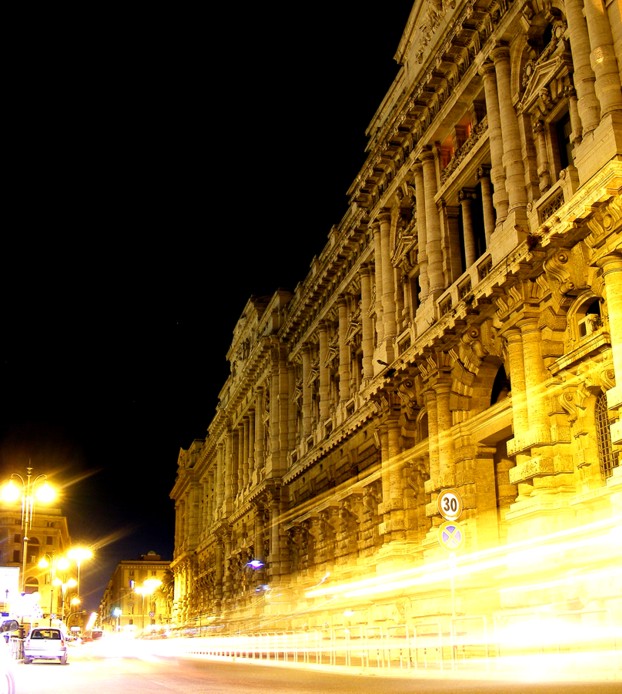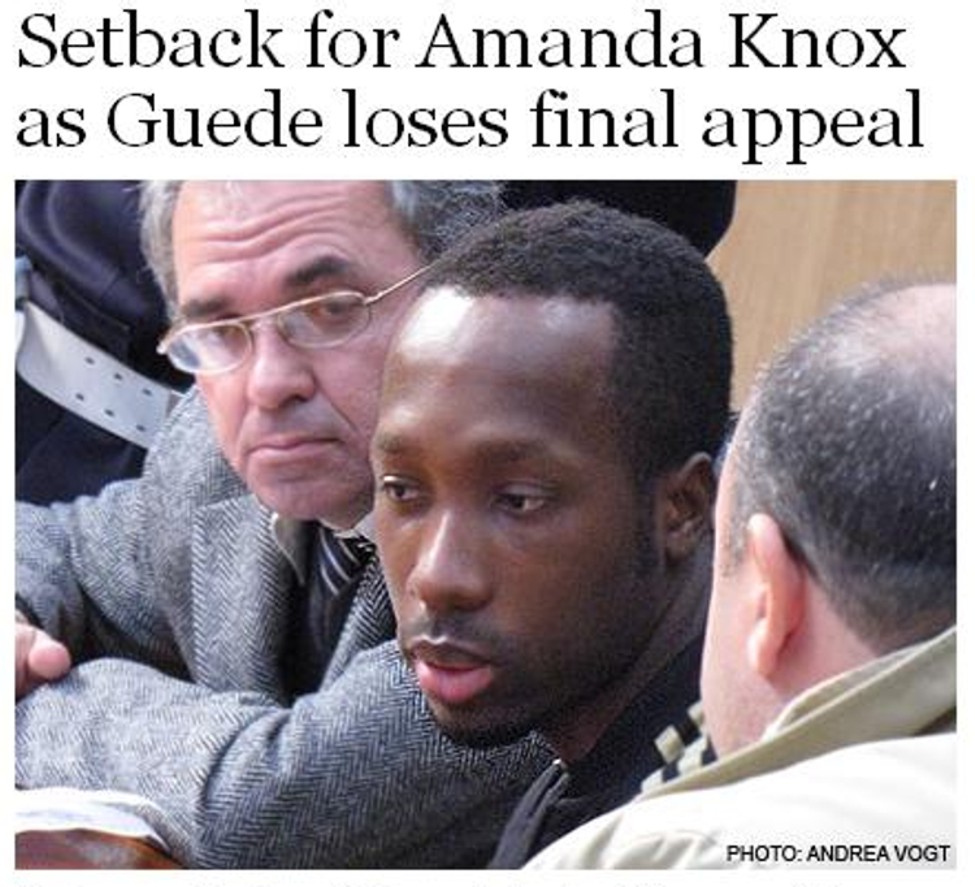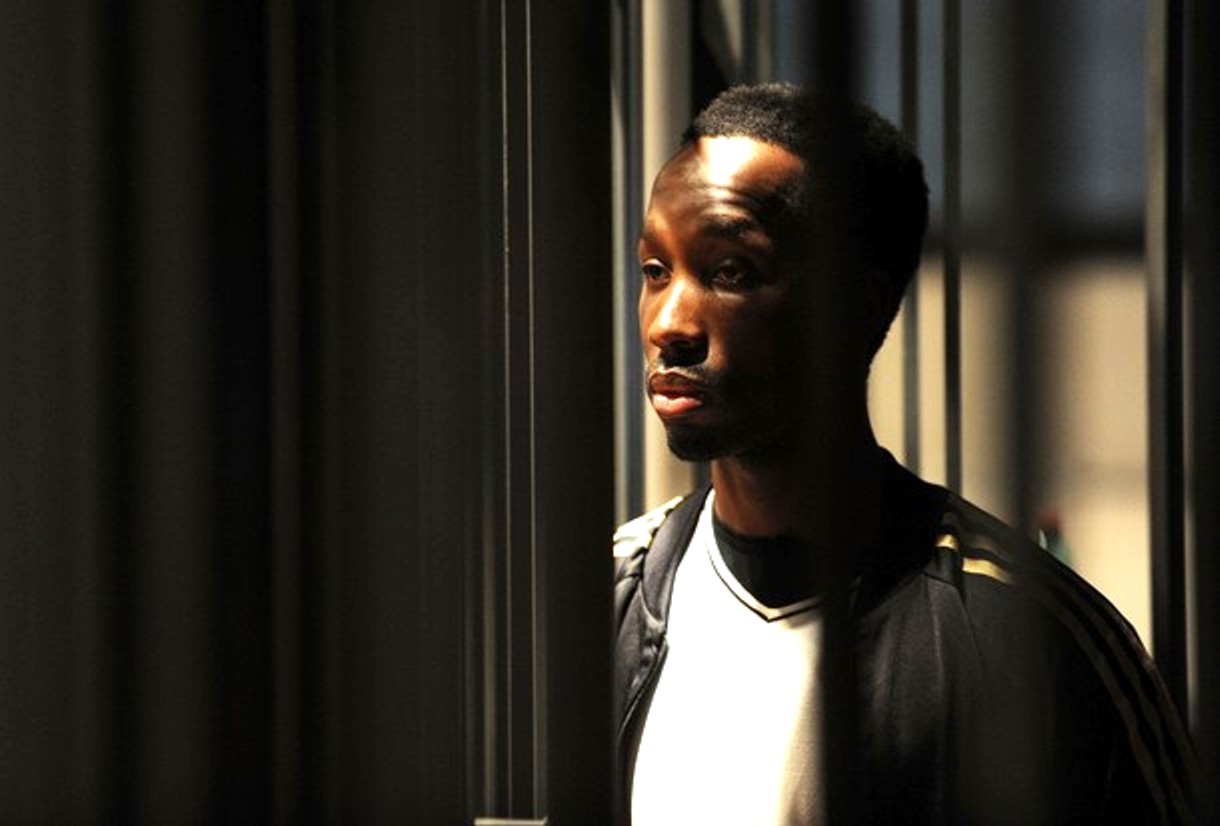
Political & economic headsup: US is demonstrating unsorted systems problems in spades. Do watch your investments. As Washington DC policy gets more & more off-target, big New York investors are betting very heavily that stocks will soon crash. Gross systems mismanagement 2017-20 tanked stocks several times.
Category: Guede appeals
Wednesday, April 08, 2015
In Big Complication For Cassation Guede Demands New Trial To Prove He Was Not “Accomplice Of Myself”
Posted by Peter Quennell

Above: Rudy Guede’s smart lead lawyer Walter Biscotti on another high profile case
The Fifth Chambers of the Supreme Court was the one that allowed Knox and Sollecito to walk free.
Sooner or later they must explain. Initial statements of their reasons has many Italian justice officials in strong disbelief.
If there were evidence problems (and we know of next to none and hundreds of evidence points suggesting guilt) the Florence appeal court was the correct court to put them to bed. Cassation has no legal mandate for that.
It gets worse. Somehow the Fifth Chambers has to explain why the First Chambers ruled the other way on some very key points in 2010 and 2013 and why it confirmed Knox’s sentence for the felony of calunnia with no further possibility of appeal.
It gets worse. The five judges would seem to have to come down for either the highly discredited Lone Wolf Theory or for two other “missing killers” (for which there is zero evidence) to have attacked Meredith.
From 2007 to 2015 two defense teams tried very hard but without conviction or success to do both of those things - even though Guede and his defense had no way to answer back as they were not even in court.
Those same two teams tiptoed away from much of the pesky evidence against all three which they were simply powerless to explain.
So Guede’s demand for a new trial reported today could not be timed worse from the Fifth Chambers judges’ point of view.
Chances are that this request will be ruled on by another Chambers of Cassation. It might take some time but they might have no compunction (especially if they are the First Chambers) about hanging the increasingly embattled Fifth Chambers out to dry.
No way Guede’s conviction ever gets reversed. He knows that. We all know that. The evidence is way too strong. But Guede could really rub it in that he was not the initiator of the 15-minute attack and could certainly not have done it alone. That he had no motive at all. That he was not a drug dealer or a burglar - no evidence for either exists.
That he was not the one who had a reason to clean up the house as his own trial ruled. And that he did not wield the final blow.
*****
Added to the top post on Thursday, and amended Friday.
It looked briefly like his lawyers contradicted Guede. But legally Guede is the one with much at stake and gets to call the final shots.
And Biscotti merely added that while he didn’t know exactly what Rudy said, his words should not be considered as a public statement, he did not intend for them to go public.
Of course, Biscotti would want to keep their powder dry, and keep Guede out of harms way, and keep all possible options open in Cassation.
Smart legal, safety and financial tactics.
Friday, August 15, 2014
Legal Timeline Of The Main Case, On Which The Next Ruling By Supreme Court Could Be Final
Posted by catnip

Cassazione (Supreme Court of Italy) seen from the east across the Tiber River
Todays Status
The Supreme Court is due to rule, possibly in the autumn, on what might be the final appeal by Sollecito and Knox on grounds which have not been published. Main steps prior to this:
November 2007
Meredith Kercher is found violently killed in her home while studying abroad in Italy. Her housemate, Amanda Knox, and Amanda’s friend Raffaele Sollecito, as well as Amanda’s boss, Patrick Lumumba, are arrested. A fourth person, Rudy Guede, is tracked down and also arrested. Patrick Lumumba’s alibi is confirmed and he is released.
December 2007, January 2008
Due process hearings authorise the continuation of preventative custody for the suspects, on the grounds of flight risk and possibility of tampering with the evidence.
October 2008
Preliminary Hearing Court, Perugia, Micheli presiding ““ after investigations have completed, the committal hearing finds there is a case to answer and remands Amanda Knox and Raffaele Sollecito to stand trial on the charges of :
- (A) aggravated murder in company of Meredith Kercher
(B) illegal transport of a knife from Raffaele Sollecito’s apartment
(C) aggravated sexual assault in company of Meredith Kercher (later folded into charge (A), on the grounds of being part of the same criminal event)
(D) illegal profiting by possession, to wit: of a sum of money approx. €300 and of credit cards belonging to the victim, and her mobile phones
(E) simulation of a crime, to wit: staging a break-in in Filomena Romanelli’s room
(F) Amanda Knox, in addition, calunnia, for falsely claiming, knowing him to be innocent, Diya Lumumba also called “Patrick”, of being the author of the murder
Rudy Guede is tried summarily “on the papers”, as he has requested the expedited trial procedure (“fast-track” trial) and is found guilty of charges (A) and (C), and not guilty of the theft, charge (D), and sentenced to life, automatically discounted to 30 years for choosing the expedited trial procedure.
December 2009
On appeal to the Court of Appeals, Perugia (4/2009, on 22 December 2009), his sentence is reduced to 24 years, automatically discounted to 16 years, the aggravating factors of the charges not being found by the court. His final appeal, to the Supreme Court of Cassation, First Criminal Section, is rejected (7195/11, hearing of 16 December 2010, reasons handed down 24 February 2011).
December 2009
Court of Assizes, Perugia, presided over by Massei ““ finds Amanda and Raffaele guilty of all charges (except the theft of the money and credit cards) but without the aggravating factors applying, and sentences them, with mitigating factors included, to 26 years for Amanda, and 25 years for Raffaele (the extra year for Amanda being for the calunnia).
October 2011
Court of Appeals of the Court of Assizes, Perugia, presided over by Hellmann (after a last-minute replacement) ““ trial convictions quashed, except for the calunnia charge against Amanda (charge (F)), where sentence was increased to time served (3 years); both prisoners released (4/2011, decision 3 October 2011, reasons handed down 5 December 2011).
March 2013
The Supreme Court of Cassation (25/3/2013) found the acquittals on charges A&C, B, D, and E to be unsafe, and annulled that part of the decision, remanding the matter to the Florentine jurisdiction, as per the usual cascade rules, for a fresh determination, and rejected Amanda Knox’s appeal on the charge (F) conviction and sentence.
January 2014
Court of Appeals, Second Chamber, Florence, presided over by Nencini ““ trial convictions on the non-calunnia charges upheld, therefore sentence increased to 28 years and 6 months for Amanda (11/13, decision 30 January 2014, reasons handed down 29 April 2014). All convicted parties to pay the relevant compensation to the various injured parties. Appeals to the Supreme Court of Cassation have been lodged.
Associated Timelines
See the posts here and here on the timing of events arrived at by the trial judges.
Sunday, November 10, 2013
The Crime-Scene Clean-Up: How Rudy Guede’s Diary Provides Even More Proof That It Happened
Posted by pat az
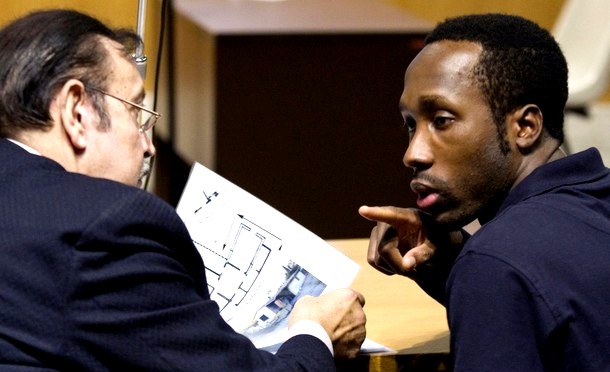
This post is crossposted from my own place. Here is one of my previous crime scene analyses on TJMK.
Rudy Guede was ultimately declared convicted by the Supreme Court in 2010 of participating in the 2007 murder of Meredith Kercher.
The prosecution claims the two other participants are Amanda Knox and Raffaele Sollecito. Knox and Sollecito are currently appealing their conviction of the same crime.
The case against the three of them involves a suspected clean up of the hallway in the apartment after the crime. Meredith’s blood was found in the bathroom, and half a footprint in her blood was found on the bathroom mat. However, there was no visible blood between Meredith’s bedroom and the bathroom.
The only visible blood in the hallway were faint partial shoe prints that led directly out the front door of the apartment.
After the murder was discovered, the media reported almost daily on developments in the case. The day of the murder, the press reported on the blood found in the bathroom and the bedroom.
But until police used luminol at the apartment on December 18th, the media didn’t report on any significant blood found in the hallway. Between November 2nd and December 18th, only one person stated that significant amounts of blood had been in the hallway.
Rudy Guede.
Rudy Guede actually wrote about it in his diary between Nov 20th and Dec 6th, after being captured in Germany.

The police arrived at the apartment on November 2nd. According to media reports, the blood they spotted immediately was only in the bathroom and Meredith’s bedroom. When the scene was more closely examined, after the discovery of the body, police found visible blood patterns on the floor left by Guede’s left shoe as he left the apartment.
None of the people who arrived in the apartment on the afternoon of November 2nd reported seeing them; these footprints are not in any of the stories of the events of Nov 2nd told by Amanda Knox nor Raffaele Sollecito. So, while these prints were visible, they were not substantially obvious.
On December 18th 2007 investigators applied Luminol in the hallway and other bedrooms. This forensic chemical is used to detect blood which has been cleaned away. The Luminol revealed several footprints in the hallway between the bedrooms of Knox and Meredith. Example below. Some of these footprints were leading towards Meredith’s door.
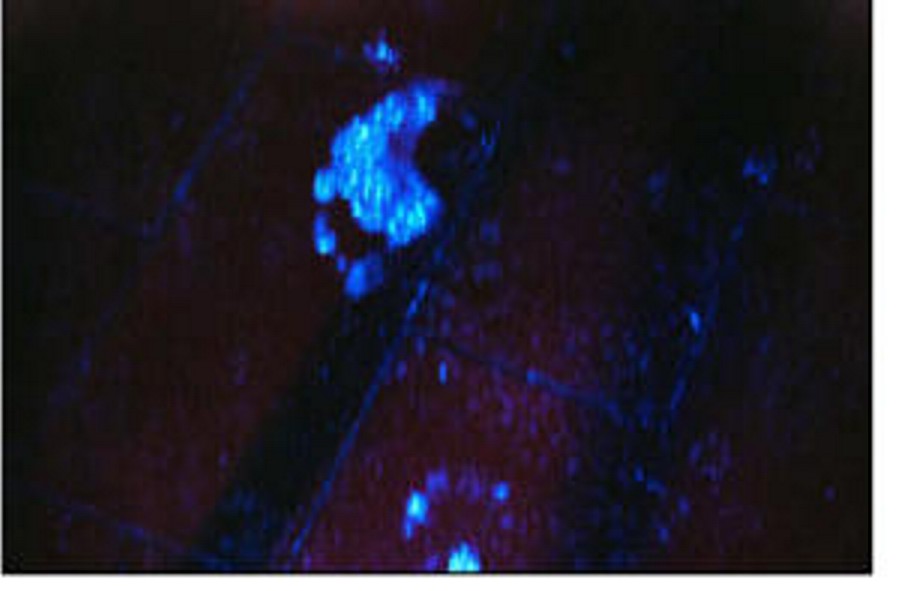
They also discovered prints in Filomena’s room which contained Meredith’s DNA and Amanda Knox’s DNA. They also revealed a footprint in Amanda Knox’s bedroom. (The defense unsuccessfully contested the investigator’s conclusions that these prints were made with blood).
On November 19 2007, an international arrest warrant was issued for Rudy Guede. He was arrested in Germany on November 20th. Guede remained in Germany until his extradition on December 3rd.
During his stay in jail in Germany, Guede wrote a long statement that was published and translated. Guede’s writings are similar to to Knox’s jail writings in many ways - they both try to write out their own detailed version of events, while pointing blame elsewhere.
But Guede’s comments may in fact be confirmation of a clean-up after the murder of Meredith Kercher (emphasis added):
I am asking myself how is it possible that Amanda could have slept in all that mess, and took a shower with all that blood in the bathroom and corridor? (Guede, Germany Diary, P21)
The police did not find evidence of any other blood until December 18th, AFTER Guede returned from Germany. As indicated above, the luminol revealed multiple footprints in the hallway, in Knox’s bedroom, and in Filomena’s bedroom. The image below shows these results in blue. Guede’s partial footprints are shown in red.
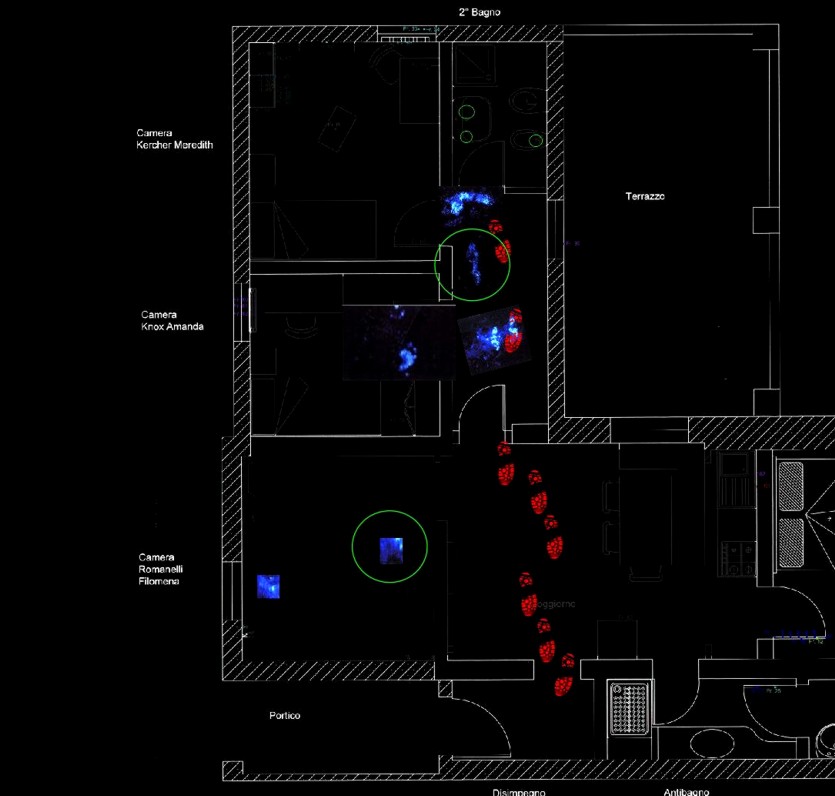
The conclusion is inescapable: Guede knew there would be significant evidence of blood in the hallway, before the police themselves found that evidence.
How did Guede know there would be more blood found in the hallway, before the police found that evidence on December 18th? And why wasn’t that blood there on the morning of November 2nd?
The courts believe the blood in the hallway was cleaned after the murder of Meredith Kercher. And the Micheli and Massei courts believed only one person had the motivation to hide this evidence: Amanda Knox.
Here is a summary of Judge Micheli’s October 2008 indictment finding.
In Judge Massei’s December 2009 trial finding for the original conviction of Knox and Sollecito, he also writes about the clean-up that the judges believed to have happened:
Further confirmation is constituted by the fact that, after Meredith’s murder, it is clear that some traces were definitely eliminated, a cleaning activity was certainly carried out. In fact, the bare foot which, stained with blood, left its footprint on the sky-blue mat in the bathroom, could only have reached that mat by taking steps which should have left other footprints on the floor, also marked out in blood just like (in fact, most likely, with even more [blood], since they were created before the footprint printed on the mat) the one found on the mat itself. Of such other very visible footprints of a bloody bare foot, on the contrary, there is no trace. (Massei, Dec 09; PMF translation)
In defense of Guede, Knox, and Sollecito, some might try to claim that Guede heard about blood in the hallway in the news. Rudy Guede was arrested 18 days following the murder of Meredith Kercher. During that time he had access to read the news and watch reports.
I have searched for articles in the period between November 2nd and December 18 which mention blood. All of the articles I have found so far discuss blood in the bedroom or the bathroom. One or two discuss footprints leading to the front door.
None of them discuss blood in the hallway that would justify a statement from Guede of “tutto quel sangue nel bagno e sul corridoghe” (all that blood in the bathroom and in the corridor)
Guede himself said he went between the bedroom and the bathroom, so may have tracked blood into the bathroom and therefore known blood would be found in the hallway.
Even that knowledge however confirms a clean-up, as there was not a trail of blood between the bathroom and Meredith’s room that justifies the footprint on the bathmat and blood found in the bathroom.
I have my own questions as a result of Guede’s knowledge of blood in the hallway:
Could the attack have started in the hallway? Could the first blood shed have been on the hallway tiles?
The prosecution and courts argue that Amanda Knox had a role in the attack and murder. Knox and her supporters are very adamant that there is no trace of Knox in Meredith’s bedroom. While the courts argue otherwise, could Knox’s role have been limited to the hallway?
Sadly, we may never know the full truth of what happened on the evening of November 1st, 2007.
My timeline of media reports on blood
- Nov 2nd: Meredith Kercher found. Blood found in bathroom.
- Nov 5th: Police analyzing traces of blood from apartment below.
- Nov 5th: A “trail of blood” is on the inside handle of the door to the apartment.
- Nov 7th: reports of Amanda Knox’s statements, includes finding blood in the bathroom.
- Nov 14th: Police use of Luminol at Sollectio’s house. First reports on the knife seized by police from Sollecito’s house.
- Nov 19th: Analysis of blood in bedroom (pillow, bra, etc).
- Nov 22nd: Guede’s prints in blood.
- Nov 27th: Amanda Knox’s blood on bathroom tap.
- Nov 28th: Blood in bathroom.
- Dec 5th: Reports of Guede’s letter to father: “there was so much blood”.
My timeline of main events involving Guede
- Nov 2nd, 2am ““ 4:30 am: Guede seen by witnesses at Domus nightclub.
- Nov 3: Guede leaves Perugia for Germany
- Nov 11: Guede’s cell phone tracked in Milan (Corriere)
- Nov 12: Newspaper reports a 4th suspect.
- Nov 19: Guede identified as suspect in newspapers
- Nov 19: Guede skype conversation with friend.
- Nov 20: Patrick released from prison.
- Nov 20: Guede arrested while trying to return to italy on train in Germany.
- Nov 21: Guede interrogated by German police; Guede admits to being at apartment, blames an italian man for murder.
- Nov 20-Dec 5: Guede writes diary in German prison.
- Dec 3: Germany grants Guede’s extradition back to Italy.
- Dec 6: Guede returns to Perugia.
- Dec 7: Guede interrogated by Magistrate.
- Dec 14: Guede ordered to remain in prison.
- Dec 17: Knox is questioned by Mignini.
- Dec 18: Police use luminol in apartment and find footprints in hallway and in Filomena’s bedroom.
Monday, June 27, 2011
Rudy Guede For The First Time Sort Of Accuses Knox And Sollecito Face To Face
Posted by Our Main Posters
1. Potentially A Huge Day
Tension was really fraught. Everybody involved in the appeal and everybody watching in Italy knew this could be THE day.
Guede had recently lost his final Cassation appeal and in a very hard-line ruling Knox & Sollecito had also been associated with the crime.
He was at this appeal hearing as a prosecution witness, because he had written a letter to the prosecution heatedly denying the claims of a former cellmate, Alessi, that he had said Knox and Sollecito did not attack Meredith with him, another two had.
With seeming nothing to lose, Guede could both deny Alessi’s claim and definitively point the finger of blame at the pair, and thus all three would remain locked up for many years.
2. How The Day Actually Went
Despite a turbulent day in court this was not a shapeshifter event. The problem was that Guede was far too nervous to testify.
He is not normally nervous, but it is rumored that the name of Sollecito’s mafioso Uncle Rocco might have been been whispered in his ear.
So his prison letter was read out for him by the prosecution, and it did include this.
This splendid, marvelous girl was killed by Raffaele Sollecito and Amanda Knox.
Then Sollecito lawyer Bongiorno grew increasingly frustrated in attempting a cross-examination, and Guede ended up barely saying a word. The letter alone is rather diminished evidence.
3. Duncan Kennedy for The BBC
See this on the BBC website by Duncan Kennedy.
Amanda Knox and her ex-boyfriend did kill Meredith Kercher, a man who was also convicted of the 21-year-old’s murder has told an appeal court.
After Rudy Guede confirmed he believed the US student killed her British housemate, Knox jumped to her feet saying she was “shocked and anguished”.
The hearing in Perugia is the first time that all three defendants have given evidence on the same day.
Knox, 23, and Raffaele Sollecito, 26, are appealing their convictions.
Child killerMiss Kercher, of Coulsdon, Surrey, was found with her throat cut at her Perugia flat after what prosecutors claimed was a sex game taken to the extreme.
Knox is serving a 26-year sentence for Miss Kercher’s murder while her Italian co-defendant and ex-boyfriend, Sollecito, was sentenced to 25 years.
Guede told the court that claims by a fellow prison inmate that he thought Knox and Sollecito were innocent were not true. He said he never made that claim to the inmate.
On 18 June, convicted child killer Mario Alessi told the appeal Guede had confided that Knox and Sollecito were innocent.
According to Alessi, Guede said he and a friend went to the house Miss Kercher shared with Knox with the intent of having sex with Miss Kercher and that when she refused, the scene turned violent and his unnamed accomplice slit her throat.
Drug-dealer Guede was jailed for 30 years for the sexual assault and murder of Miss Kercher after a separate fast-track trial. His sentence was reduced to 16 years on appeal.
Guede was in the witness stand as a letter he had written in response to Alessi’s claims was read to the court on Monday.
“This splendid, marvellous girl was killed by Raffaele Sollecito and Amanda Knox,” the letter said.
Guede has previously admitted being in the house at the time of the murder, but denies involvement in Miss Kercher’s death.
After cross-examination by the defence, Guede said he had always believed Sollecito and Knox were behind the murder.
“I’ve always said who was there in that house on that cursed night,” he told the court.
Knox stood up after Guede’s evidence and denied his claims.
“The only time that Rudy Guede, Raffaele and I were in the same space has been in court. I’m shocked and anguished.
“He knows we weren’t there and have nothing to do with it,” she said.
Sollecito said Guede was always talking “about a shadow that could be me and a voice that could be Amanda’s… we’ve been fighting shadows for four years. Our lives have been destroyed in a subtle and absurd way.”
Speaking before Monday’s hearing, Knox’s mother Edda Mellas told reporters she hoped that Guede would have the “integrity to stand up and tell the truth”.
She said her daughter was “always very anxious and nervous but I think she’s glad things are moving along. She feels things are going well,” but that it is, “hard to get too hopeful, especially after the first trial.”
Two other witnesses were called to counter claims made by another defence witness, a member of the Mafia named Luciano Aviello, who had told the court earlier this month that his brother - who is on the run - had killed Miss Kercher during a botched burglary.
The two witnesses - two inmates at the same prison as Aviello - testified that Aviello had said he had been contacted by Sollecito’s defence team to stir up confusion in the trial in exchange for money.
Witness Alexander Ilicet said Aviello had wanted the money for a sex-change operation.
4. Andrea Vogt For The Seattle PI
See this in the report in the Seattle PI by Andrea Vogt.
As if the appeal wasn’t bizarre enough, two convicts were called by the prosecution as counter witnesses Monday to contradict several inmates called by the defense earlier this month.
They maintained they had overheard in prison conversations about a plot among other inmates to testify in exchange for money and benefits, such as reduced prison time.
The person they heard was arranging things, they said, was Sollecito’s attorney, Giulia Bongiorno, who heads up Italy’s parliamentary justice committee.
She forcefully denied the corruption accusations in the break afterwards and vowed to file charges and take legal action against her accusers.
One claim by the inmates was that Bongiorno offered a sex change operation to Luciano Aviello. It would be helpful if some of this if it exists emerged on tape. What possible reason would they have to lie?
5. And So To The Bottom Line
Along with Judge Hellman’s increasingly evident bias, and the smoke being blown over the DNA, and the Sollecitos and Bongiorno not (at least not yet) investigated by the judge for alleged witness bribes, not to mention Uncle Rocco’s power to alarm even by whispered mention of his name, the Knox and Sollecito defenses are down, but not yet for the count.
6. And A Footnote On The Kabuki Dance
This for the first time on Guede’s side (but not on Knox’s or Sollecito’s side) crosses a public boundary between the three.
The Italian lawyer Cesare Beccaria explained it thus..
Friday, March 25, 2011
Giordano Supreme Court Report On Final Appeal By Rudy Guede
Posted by Our Main Posters

[St Peters in foreground; Supreme Court large white building in background]
Please click on the image above for this meticulous translation from Italian to English.
The PMF translation team on three continents consisted of Jools, Thoughtful, Clander, TomM, Catnip, Yummi and the 411.
This post spelled out how very ominous for the Knox and Sollecito defenses this report really is.
We will have a post soon examining the fine details of this very tough report.
Saturday, February 26, 2011
Very Hard Language Of Supreme Court In Rejecting Guede Appeal, Confirming Three Did It
Posted by Peter Quennell
The report of the Supreme Court of Cassation released on Thursday was foreshadowed in content in our post of 17 December:
Rudy Guede’s appeal is rejected on all ten grounds. His appeal grounds were ugly and dishonest and he has no further appeal. He will serve his 16 years, with maybe some time off, for being a savage willing party to the cruel stupid murder of Meredith.
Rudy Guede will go down in infamy for his sex crime against a defenseless victim, for being a party to a taunting torturing knife attack, for claiming Meredith invited him in for consensual sex, and for not calling for help for Meredith and maybe saving her life while it was still possible.
Cassation continues the fine Italian court tradition in this case of taking a firm and unblinking position, and for being utterly oblivious to the vile over-the-top campaign of Curt Knox, Edda Mellas and David Marriott which may now haunt Amanda Knox all of her life.
What really caught the Italian media’s attention and made this the second most widely reported development in the case after the Amanda Knox-Raffaele Sollecito verdict was the icy hard language, the pure contempt for the depraved pack attack, the total rejection of all Guede’s stories, including his oft-repeated and totally unbelievable claim that Meredith invited him in and wanted love-making, and the court’s conclusion once again that the evidence methodically described in the Micheli Report overwhelmingly proves that THREE perpetrators took part in the crime.
The Court of Cassation in this report made clear that Knox and Sollecito are not already formally nominated as the other two perpetrators and it does wait the referral of the outcome of the present appeal in Perugia. But unless the defense witnesses Alessi and Aviello can indeed convince Judge Hellman’s appeal court that Guede attacked Meredith with friends or that some other people entirely carried out the attack, there seems no way out for them.
The court also indicated that it considered the motive of the attack on Meredith to be frivolous, which is precisely what the prosecution claims in the current Perugia appeal as grounds for rejecting Massei’s mitigating circumstances, and for increasing Knox’s and Sollecito’s prison sentences to life terms.
This post of a month ago further explains Knox’s and Sollecito’s almost insurmountable problems.
The written report from Cassation on that December 2010 decision on Guede’s final appeal (due soon), plus Judge Micheli’s Sentencing Report for Rudy Guede of January 2009, plus all that associated evidence, now gets automatically ported by law straight into Knox’s and Sollecito’s appeal.
Judge Micheli took a hard line toward Rudy Guede, and he sentenced him to 30 years. He also remanded Knox and Sollecito to trial, and his report explains the basis for that remand.
Judge Micheli’s remorseless and tightly argued report (see summaries below) very comprehensively backed up his decisions. (Later reductions in sentence were automatic and they flowed from the terms of Guede’s short-form trial, and some controversial mitigating circumstances advanced by Massei for Knox and Sollecito.)
The prosecution’s appeal against the Knox and Sollecito sentences argues that the acceptance of mitigating circumstances by the Massei court should be thrown out, and that Knox and Sollecito should be subjected to a longer sentence. Remember that even in the case of Alessi’s wife, who was not even present when he beat the kidnapped baby to death, she received a sentence of 30 years.
So here is how it is stacking up:.
For the prosecution, four courts including the Supreme Court of Cassation have ruled that three people participated in the crime against Meredith, plus all of the evidence from both the Guede and Knox Sollecito trials now comes in, plus the prosecution is appealing for tougher sentences, which seems well justified based on precedents.
And for the defenses? Will they now feel they have no choice but to put Knox or Sollecito or Alessi or Aviello or for that matter Rudy Guede on the stand as a last-ditch manoeuvre?
Hard to see what further they have to lose.
Thursday, January 20, 2011
The New 80,000 Pound Gorilla In The Room Introduced By The Italian Supreme Court
Posted by Our Main Posters

[St Peter’s and the Vatican in background; Palace of Justice, large white building by river in left foreground]
What is the biggest headache for the defenses?
That their areas of appeal, already circumscribed by Judge Hellman, could all explode in their faces? The low-credibility witnesses Alessi and Aviello? The limited DNA retesting? The re-examination of the witness in the park who had no cause to make anything up?
Or that Rudy Guede gets totally ticked off by Alessi’s claims that Rudy Guede said he did it with one or two others, and so Guede tells the court all that REALLY happened?
No, it looks to us that the defenses’ biggest headache by far is that the court of final appeal in Rome (the Supreme Court of Cassation, which is superior to the Perugia appeals court and will hear the second and final appeal) has ALREADY accepted that Rudy Guede’s sentencing report of January 2009 holds up.
And that all three of them attacked Meredith.
The written report from Cassation on that December 2010 decision on Guede’s final appeal (due soon), plus Judge Micheli’s Sentencing Report for Rudy Guede of January 2009, plus all that associated evidence, now gets automatically ported by law straight into Knox’s and Sollecito’s appeal.
Judge Micheli took a hard line toward Rudy Guede, and he sentenced him to 30 years. He also remanded Knox and Sollecito to trial, and his report explains the basis for that remand.
Judge Micheli’s remorseless and tightly argued report (see summaries below) very comprehensively backed up his decisions. (Later reductions in sentence were automatic and they flowed from the terms of Guede’s short-form trial, and some controversial mitigating circumstances advanced by Massei for Knox and Sollecito.)
The prosecution’s appeal against the Knox and Sollecito sentences argues that the acceptance of mitigating circumstances by the Massei court should be thrown out, and that Knox and Sollecito should be subjected to a longer sentence. Remember that even in the case of Alessi’s wife, who was not even present when he beat the kidnapped baby to death, she received a sentence of 30 years.
So here is how it is stacking up:.
- For the prosecution, four courts including the Supreme Court of Cassation have ruled that three people participated in the crime against Meredith, plus all of the evidence from both the Guede and Knox Sollecito trials now comes in, plus the prosecution is appealing for tougher sentences, which seems well justified based on precedents.
- For the defenses, just those few areas the defenses want to challenge which have been allowed by Judge Hellman NONE of which are sure things.
Really not very much going for the defenses here. No wonder they already seem to be phoning it in.
Our meticulous summaries of the Micheli Report by main posters Brian S and Nicki were based on our own translation. A huge amount of work. They were posted nearly two years ago. Periodically we link to them in other posts or we point to them in an email.
Those who do read those posts fresh are often stunned at their sharpness, and for many or most it becomes case closed and the verdict of guilty is seen as a fair one.
We think those posts on Micheli are so key to a correct grasp of Knox’s and Sollecito’s appeal prospects that they should now be reposted in full.

[St Peter’s and the Vatican in foreground; Palace of Justice, large white building in left background]
Understanding Micheli #1: Why He Rejected All Rudy Guede’s Explanations As Fiction
By Brian S
Judge Micheli has had two very important roles. He presided over Rudy Guede’s trial and sentencing, and he presided over the final hearing that committed Raffaele Sollecito and Amanda Knox to trial.
A week ago, just within the three-month deadline, Judge Micheli made public the 106-page report that explains the thinking behind both actions. This is a public document, and in the enviable Italian legitimizing process, the public is encouraged to get and read the report and to understand the full rationales. Excellent analyses have already appeared in Italian in Italy, but no English-speaking sources on the facts of the case have either put the report into English or published more than the most superficial analysis.
These posts will examine several very key areas of the report so that we too may choose whether to buy into the rationales. The translations into English here were by native-Italian speakers and fellow posters Nicki and Catnip. The next post will explain why Micheli ruled out the Lone Wolf Theory, and why he concluded that Knox and Sollecito appeared to be implicated in Meredith’s murder and should therefore be sent to trial.
Judge Micheli maintained that from the moment Meredith’s body was discovered until his arrest in Germany on November 19th, Rudy Guede was in a position to compile a version of his involvement in events at the cottage which would minimise his reponsibilities and point the finger of guilt elsewhere.
He was able to follow the course of the investigation in newspapers and on the internet. He would know of the arrests of Amanda, Raffaele and Patrick. He would know that the investigators had found biological evidence which would sooner or later connect him to the murder, and he would know of other discoveries and evidence which had been publicised in the media.
His story as told in Germany was compiled with all the knowledge about the crime and investigation he would have sought out. On his return to Italy in December he was interviewed by the investigating authorities and gave version 2. He was interviewed again in March which resulted in version 3, and later still made a spontaneous statement to change one or two facts including the admission that the trainer footprint in Meredith’s room could be his. Judge Micheli said:
- Analyzing the narratives of the accused…he is not credible, as I will explain, because his version is (1) unreliable, and (2) continuously varying, whether on basic points or in minor details and outline.
Micheli then examined the details of Rudy’s claimed meeting with Meredith which resulted in his invitation to the cottage on the evening of November 1st.
He noted there were substantial differences between his versions of December and March, particularly with regard to the location of his meeting with Meredith on the night of Halloween and his movements in the early evening of November 1st.
He considered it likely that Rudy had made these changes as he became aware of evidence which contradicted his December version. Notably, in December Rudy claimed to have had his meeting with Meredith which resulted in her invite at a Halloween party given by Spanish students.
By March it was well known that Meredith had spent her entire Halloween in the company of friends, first in the Merlin pub before they later moved on to Domus disco. In March Rudy changed the location of his meeting with her from the Spanish party to Domus, which by chance Rudy had also attended following the party. However, neither Meredith’s friends who were continuously in her company nor those who accompanied Rudy to the Domus witnessed any meeting between the two. Judge Micheli commented:
- On 26 March 2008, instead, Rudy explained to the Prosecution, drawing a picture, that the group invited to the Spaniards’ house actually moved wholus-bolus to the “Domus” club, but it was right in that nightclub that he met Kercher, and not before; offering up a tour-guide description from the chair, saying, “there’s a bar for the drinks and then there’s a room, there’s an arch and a room. I walking [sic] around there, and that’s where I met Meredith”. On the facts of the meeting and the subject of the conversation, he elaborated: “I started talking to Meredith “¦talking anyway I gave her a kiss.. after which I told her how much I liked her and asked her if the next day, in all the confusion anyway, if we were going to meet the next day and she said yes (”¦), we met in the evening around half eight, like that.
While not intending to explore the question, basically irrelevant, of whether the pair had agreed to a more or less specific time (his confirmation of the suggestion of 8.30 pm in both verbal statements however allows the inference that according to Guede they had an appointment), the patent contradiction between the two versions jumps out. One context, of a room between two bathrooms, in an apartment, is completely different to that of a drinks-bar and an arch, in a pub; one might concede, perhaps, the possibility of forgetting which place it was where they last bumped into a friend, but hardly the first time there was a kiss with a girl towards whom one was attracted.
With regard to his movements in the early evening of November 1st, Rudy’s friend Alex failed to corroborate Rudy’s December claim to have visited his flat. He said he didn’t see Rudy either before or after his meeting with Meredith at her cottage.
In March, Rudy changed his story and claimed to have risen at 6pm(following the all-nighter at Domus) before wandering around town for an hour or so. He then said he went to Meredith’s cottage but received no answer so he carried on to Piazza Grimana in the hope he might see people he knew. He thought he arrived in the Piazza at around 7:30pm. He claimed that some time later he left Piazza Grimana and called at the Kebab shop before returning to Meredith’s cottage and arriving some time between 8:30 and 9:00pm.
He said he then waited until her arrival some time just after 9:00pm. It was noted that in both his December and March versions Rudy said he had arranged to meet Meredith at 8:30pm. Micheli noted that this didn’t sit well with another arrangement Rudy had made to meet Carlos (from the Spanish party) between 9:00 and 10:00pm.
Micheli said that neither version of Rudy’s movements could be treated as true because he changed his story to fit facts as they became known and there was absolutely no corroborating witness evidence.
Rudy claimed two situations evolved following his entry with Meredith into the apparently empty cottage:
Whilst he was having a drink of fruit juice from the fridge, he claims Meredith found that 300 euros (her rent money) was missing from her bedside cabinet. Meredith was naturally upset by this discovery and straight away blamed “druggy Amanda”. Rudy said they both checked Amanda’s room to see if the money was there. However, it couldn’t be found and Rudy sought to console her.
He says that this consolation developed into an amorous encounter which proceeded to the stage where “Meredith asked him” if he had a condom. He told he didn’t and since she didn’t either they stopped their lovemaking.
Judge Micheli had a real problem with this story as told by Guede. He found it unlikely that Meredith would be interested in lovemaking so soon following the discovery that her money was missing. He found it unlikely that it was Meredith who was leading the way in this amorous encounter as Rudy was suggesting with his claim that it was “Meredith who asked him” if he had a condom.
Surely, Micheli reasoned, if Rudy was hoping to indulge in a sexual encounter with Meredith following the previous night’s flirting, he would, as any young man of his age, ensure that he arrived with a condom in anticipation of the hoped for liason. But even if he didn’t, and it was true that events had reached the stage where Meredith asked him, then surely given his negative response, Meredith would have again gone into Amanda’s room where, as she had told her friends, condoms were kept by her flat mate. Judge Micheli simply didn’t believe that if they had got to the stage of lovemaking described by Rudy, and following his negative response to her question, they just “STOPPED”. Meredith would have known she had a probable solution just metres away.
Rudy claimed he then told Meredith he had an upset stomach because of the kebab he had eaten earlier. She directed him to the bathroom through the kitchen.
Rudy put on his i-pod and headphones as he claimed was his habit when using the toilet. In his December version Rudy said the music was so loud he heard the doorbell ring but he made no reference to hearing any conversation. A perfect excuse, Judge Micheli says, for not hearing the disturbance or detail of Meredith’s murder. However, in his March version he claims he heard Amanda’s voice in conversation with Meredith. When Rudy did eventually emerge from the bathroom he says he saw a strange man with a knife and then a prone Meredith. Micheli commented:
- ...it is necessary to take as given that, in this case, Kercher did not find anything better to do than to suddenly cross from one moment of tenderness and passion with him to a violent argument with someone else who arrived at that place exactly at the moment in which Rudy was relieving himself in the bathroom. In any case, and above all, that which could have been a surprise to the killers, that is to say his presence in the house, was, on the other hand, certainly not put into dispute:
Meredith, unlike the attackers, knew full well that in the toilet there was a person who she herself allowed in, so for this reason, in the face of someone who had started raising their voice, then holding her by the arms and ending with brandishing a knife and throwing her to the floor, why would she not have reprimanded/reproached/admonished him immediately saying that there was someone in the house who could help her?
“¦Meredith didn’t shout out loudly for Rudy to come and help
“¦There was a progression of violence
“¦The victim sought to fight back
If it is reasonable to think that a lady living 70 metres away could hear only the last and most desperate cry of the girl ““ it’s difficult to admit that Guede’s earphones, at 4-5 metres, would stop him hearing other cries, or the preceding sounds.
Micheli was also mystified as to why Amanda (named in Rudy’s March version) would ring the doorbell. Why wouldn’t she let herself in using her own key? He supposed it was possible Meredith had left her own key in the door which prevented Amanda from using hers, but the girls all knew the lock was broken and they were careful not to leave their own key in the door. Perhaps, Meredith wanted some extra security/privacy against someone returning and had left her key in the lock on purpose. Maybe Amanda was carrying something heavy and her hands weren’t free. Or, maybe, Rudy was just trapped by his December story of the doorbell when he didn’t name anybody and an anonymous ring on the doorbell was plausible.
The judge then took issue with Rudy’s description of events following the stabbing of Meredith. Rudy claimed that when he emerged from the bathroom he discovered a man with a knife standing over Meredith. In the resultant scuffle he suffered cut wounds to his hand. armed himself with chair to protect himself. before the attacker fled when he fell over because his trousers came down around his ankles. Micheli said that those who saw Rudy later that night didn’t notice any wounds to Rudy’s hands although some cuts were photographed by the police when he was later arrested in Germany.
Micheli found Rudy’s claim that the attacker ran from from the house shouting “black man found, black man guilty” unbelievable in the situation. In the panic of the moment it may be conceivable that the attacker could shout “Black man…, run” following the surprise discovery of his presence in the house, but in the situation Rudy describes, blame or expressions of who the culprit thought “the police would find guilty” made no sense. It would be the last thing on an unknown attackers mind as he sought to make good his escape.
Micheli considers the “black man found, black man guilty” statement an invention made up by Rudy to imply a possible discrimination by the authorities and complicate the investigation. Micheli also saw this as an excuse by Rudy to explain away his failure to phone for help (the implication being that a white man could have made the call). It was known by her friends and acquaintances that Meredith was never without her own phone switched on. She kept it so, because her mother was ill and she always wanted to be available for contact should her mother require help when she was on her own
Judge Micheli regarded Rudy’s claimed efforts to help Meredith impossible to believe, given the evidence of Nara Capezzali. Rudy claimed to have made trips back and forth to the bathroom to obtain towels in an attempt to staunch the flow of bood from Meredith’s neck. He claimed to have leaned over her as she attempted to speak and written the letters “AF” on the wall because he couldn’t understand her attempted words. His described activities all took time and Rudy’s flight from the house would have come minutes after the time he alleged the knife-man ran from the cottage.
Nara Capezzali maintained that after she heard Meredith’s scream it was only some seconds (well under a minute) before she heard multiple footsteps running away. Although she looked out of her window and continued to listen for some time because she was so disturbed by the scream, she neither heard nor saw any other person run from the house. That Rudy had run wasn’t in doubt because of his collision on the steps above with the boyfriend of Alessandra Formica. Micheli therefore considered it proven that “all” of Meredith’s attackers, including Rudy, fled at the same time.
Earlier in his report Micheli considered character evidence on Rudy given by witnesses for both prosecution and defense. Although he had been seen with a knife on two occasions, and was considered a bit of a liar who sometimes got drunk, the judge didn’t consider that Rudy had previously shown a propensity for violence, nor behaviour towards girls which differed markedly from that displayed by many other young men of his age.
However, because of the wealth of forensic evidence [on which more later] and his admitted presence in the cottage, combined with his total disbelief in Rudy’s statements, Micheli found Rudy guilty of participation in the murder of Meredth Kercher.
He sentenced him to 30 years in prison and ordered him to pay compensation of E2,000,000 each to Meredith’s parents John and Arline Kercher, E1,500,000 each to Meredith’s brothers John and Lyle Kercher plus E30,000 costs in legal fees/costs + VAT. Also E1,500,000 plus E18,000 in legal fees/costs + VAT to Meredith’s sister, Stephanie Kercher.
Understanding Micheli #2: Why Judge Micheli Rejected The Lone-Wolf Theory
By Brian S
And so decided that Raffaele Sollecito and Amanda Knox should face trial.
First, just to recap: Judge Micheli presided over both Rudy Guede’s trial and sentencing to 30 years and the final hearing that committed the two present defendants to trial.
Ten days ago, Judge Micheli made public the 106-page report that explains the thinking behind both actions. This is a public document, and in the enviable Italian legitimizing process, the public is encouraged to get and read the report and to understand the full rationales. Excellent analyses have already appeared in Italian in Italy, but no English-speaking sources on the facts of the case have either put the report into English or published more than the most superficial analysis.
These posts are examining several very key areas of the report so that we too may choose whether to buy into the rationales. The translations into English used here were by native-Italian speakers and fellow posters Nicki and Catnip.
Right at the outset of his Sentence Report on the conviction of Rudy Guede, Judge Micheli stated that it was neither the place nor his intention to make the case against either Raffaele Sollecito or Amanda Knox. He said he must necessarily involve them to the extent that they were present at the discovery of Meredith’s body. He said he must also examine evidence against them where he saw it as indicating that Rudy Guede was not a lone wolf killer and implicated them as his possible accomplices in Meredith’s murder.
Judge Micheli described the sequence of events laid out by the prosecution which lead to the discovery of Meredith’s body:
Early on the morning of November 2nd, Signora Lana Biscarini received a bomb threat call made to her home at 5A Via Sperandio. (This later transpired to be a hoax.)
Some time later Signora Biscarini found a mobile phone in her garden. She “had heard” that bombs could be concealed in mobile phones and so she took it to the police station arriving at 10:58am as recorded by ISP. Bartolozzi
The postal police examined the phone and following removal of the SIM card, discovered at 11:38am that it belonged to a Filomena Romanelli who lived at the cottage at 7 Via della Pergola. Following a call by Signora Biscarini to check with her daughter who was still at home, it is in the record at 11:50am that neither say they know the Filomena in question. At around noon Signora Biscarini’s daughter rings her mother at the police station to say she has found a second phone.
The second phone (Meredith’s) is collected from Via Sperandio and taken to the police station. Its receipt there is logged by ISP. Bartolozzi at 12:46pm. During its examination Meredith’s phone is also logged as connecting to the cell of Strada Borghetto di Prepo, which covers the police station, at 13:00pm. At 13:50pm both phones, which have never left the police station following their finding, are officially seized. This seizure is entered in the log at 14:00pm.
Separately, as part of the bomb hoax investigation, agents of the postal police are dispatched to make enquiries at Filomena’s address in Via della Pergola.
They are recorded in the log and filmed on the car park camera as arriving at 12:35pm. They were not in possession of Filomena’s phone, which remained at the police station, nor of Meredith’s which at this time was being taken from Via Sperandio to the police station for examination as part of the bomb hoax enquiry.
Judge Micheli said that some confusion was created by the evidence of Luca Altieri (Filomena’s boyfriend) who said he saw two mobile phones on the table at the cottage. But, Micheli said, these two phones either belonged to the others who arrived, the postal police themselves or Amanda and Raffaele. They were NOT the phones of Filomena or Meredith.
On their arrival at the cottage, the agents of the postal police found Raffaele Sollecito and Amanda Knox standing outside the front door.
The two seemed surprised to see them (the postal police had come to talk to Filomena about a bomb hoax which potentially involved her phone, plus they had recently been informed of the discovery of second phone in the same garden), but then they explained they had discovered suspicious circumstances inside the cottage.
Raffaele said he had already phoned the police and they were awaiting their arrival in connection with that. Elsewhere in his report Micheli points out that Raffaele did, in fact, make a call to his sister at 12:50pm, followed by two calls to “112” reporting a possible burglary at 12:51 and 12:54pm, 15 minutes after the arrival of the postal agents.
Judge Micheli said the postal police were shown into the cottage by Raffaele and Amanda. They pointed out the traces of blood around the apartment, the state of the toilet and the disturbance to Filomena’s room. They said they didn’t think anything had been taken. They pointed out that Meredith’s door appeared to be locked, Raffaele said he had tried to open it, but Amanda said Meredith used to lock the door even when she was going to the bathroom to shower.
Shortly afterwards Luca Altieri and Marco Zaroli arrived. Luca said he had just been contacted by his girlfriend Filomena, who in turn had just been contacted by Amanda Knox about the possible break in. A few minutes later, Filomena herself arrived with Paola Grande. Micheli noted that Filomena had immediately contradicted what Amanda had told the postal police and she said that Meredith never locked her door. She also told the postal police that the phone found with a SIM card in her name was in fact Meredith’s 2nd phone, that she had given Meredith the SIM as a present. The postal police said that they didn’t have the authority to damage property and so the decision was made that Luca would break down the door.
This he did. The scene when the door flew open was instantly obvious, blood everywhere and a body on the floor, hidden under a duvet except for a foot and the top of Meredith’s head. At that point ISP Battistelli instantly took charge. He closed the door and forbade anyone to enter the room before contacting HQ.
Following his description of the events which lead to the discovery of Meredith’s body, Micheli then dedicates quite a few pages of his report to detailing the exact locations, positions, descriptions and measurements of all the items, blood stains, pools and spots etc.etc. found in her room when the investigators arrived. He also goes into precise details on the injuries, marks, cuts and bruises etc. which were found by Lalli when he examined Meredith’s body in situ at the cottage before she was moved. Despite their extent, it is obvious these details are only a summary of the initial police report and also a report made by Lalli on the 2nd November.
It is these details which allowed the prosecution to lay out their scenario for the events which they say must have happened in the room. It is also these details which convince Micheli that it was impossible for this crime to be carried out by a single person. In his report, he dismisses completely the scenarios presented by the defences of Amanda and Raffaele for a “lone wolf killing”. Micheli says that he is convinced that Meredith was sexually assaulted and then murdered by multiple attackers.
Judge Micheli also explains in his report how the law will decide on sexual assault or rape where the medical report (as was Lalli’s) is somewhat inconclusive. Else there would be no point in a woman reporting rape unless she had serious internal injuries. His conclusion: Meredith was raped by Rudy Guede manually.
So why does Judge Micheli believe that Amanda Knox and Raffaele Sollicto were possible accomplices of Rudy Guede and should be tried for the murder of Meredith Kercher?
In his report, he doesn’t look at the evidence which involves just them, nor does he analyze their various stories in his report. He doesn’t look at events involving them which occurred between the 2nd and 5th November. He does note a few items here and there, but these aren’t given as the major reasons for his decision to indict them.
He notes Raffaele’s apparent lies about the time he made the 112 phone calls. He dismisses Raffaele’s defense claim that the disposal of Meredith’s phones didn’t allow time for Raffaele to get to the cottage after watching his film, kill Meredith, and then dispose of the phones in Via Sperandio before the aborted call to Meredith’s bank. He noted that the cell which picked up the brief 10:13 call to Meredith’s bank also picked up most of Meredith’s calls home.
He asked whether it was possible for anybody to believe that each time Meredith wanted to phone home, she walked down to Via Sperandio to make the call. He notes that the police found Amanda and Raffaele’s behaviour suspicious almost straight away. He notes that Filomena said that the relationship between Amanda and Meredith had deteriorated by October. He says he doesn’t believe at all that cannabis caused any loss of Amanda’s and Raffaele’s memories.
Judge Micheli says he bases his decision on the following points of evidence:
[Note: The following paragraph numbers form no part of Micheli’s report. They are used in the context of this summary to identify the points of evidence contained in his report which will be examined and summarised in greater detail in follow-up posts]
1) Judge Micheli, after hearing both prosecution and defense arguments about Meredith’s and Amanda’s DNA on the knife and Raffaele’s DNA on Meredith’s bra clasp, accepted the prosecution argument that that both were valid evidence. He did note, however, that he fully expected that the same argument would be heard again at the full trial. In his report, Micheli dedicates several pages to explaining the opposing arguments and how he made his decision to allow the evidence. It is a detailed technical argument, and it is not proposed to examine it any closer in this post.
2) Judge Micheli explains that blood evidence proves that Meredith was wearing her bra when she was killed. Nor is it just the blood on her bra which demonstrates this. It’s also where the blood isn’t on her body. He says that Meredith was wearing her bra normally when she laid in the position in which she died, and she was still wearing it for quite some time after she was dead. Her bra strap marks and the position of her shoulder are imprinted in the pool of blood in that position. Meredith’s shoulder also shows the signs that she lay in that position for quite some time.
He asks the question: Who came back, cut off Meredith’s bra and moved her body some time later? It wasn’t Rudy Guede. He went home, cleaned himself up and went out on the town with his friends. Judge Micheli reasons in his report that it could only have been done by someone who knew about Meredith’s death and had an interest in arranging the scene in Meredith’s room. Seemingly who else but Amanda Knox?
She was apparently the only person in Perugia that night who could gain entry to the cottage. And the clasp which was cut with a knife when Meredith’s bra was removed was found on November 2nd when Meredith’s body was moved by the investigators. It was right under the pillow which was placed under Meredith when she was moved by someone from the position in which she died. On that clasp and its inch of fabric is the DNA of Raffaele Sollecito and Amanda Knox. Micheli reasons in his report that Raffaele and Amanda seemed to have returned to the cottage some time after Meredith was dead, cut off her bra, moved her body, and staged the scene in Meredith’s room.
3) Judge Micheli explains his reasoning on the method of Rudy’s entry into the cottage. He says that Rudy’s entry through the window is a very unlikely scenario and the evidence also indicates otherwise. He says the height and position of the window would expose any climber to the full glare of traffic headlights from cars on Via della Pergola. He asks, why wouldn’t a thief choose to break in through a ground floor window of the empty house? He says the broken glass and marks on the shutter both demonstrate the window was broken from the inside, some of the glass even falling on top of Filomena’s clothes which had been thrown around the room to simulate a robbery.
But his major reasoning for believing Rudy’s entry was through the front door are the bloody bare footprints which show up with luminol and fit Knox’s and Sollecito’s feet. These suggest that they entered Filomena’s room and created the scene in there after Meredith was killed. Allessandra Formica witnessed Rudy run away shortly after Meredith was stabbed. Someone went back later, left those footprints and staged the scene.
This, when considered in combination with the knowledge that person demonstrated of Rudy’s biological involvement with Meredith when they also staged the sex assault scene in Meredith’s own room indicates that that person was present when Meredith was assaulted and killed. He said it also demonstrated an attempt by someone who had an interest in altering the evidence in the house to leave the blame at Rudy’s door. Micheli reasoned, the only person who could have witnessed Rudy’s earlier sex assault on Meredith, could gain entry via the door and had an interest in altering the crime scene in the house appeared to be Amanda Knox. In his report, Micheli states that this logic leads him to believe that Amanda Knox was the one who let Rudy Guede into the cottage through the front door.
4) Judge Micheli examines the evidence of Antonio Curatolo. He says that although Curatolo mixes up his dates in his statement, he does have a fix on the night he saw Amanda and Raffaele in Piazza Grimana sometime around 11:00 to 11:30pm. Curatolo is certain it was the night before the Piazza filled up with policemen asking if anyone had seen Meredith. In his evidence, he says they came into the square from the direction of Via Pinturicchio and kept looking towards the cottage at Via della Pergola from a position in the square where they could see the entrance gate.
Judge Micheli reasons in his report that their arrival from Via Pinturicchio ties in with the evidence from Nara Capazzali that she heard someone run up the stairs in the direction of that street. He also reasons that they were likely watching the cottage to see if Meredith’s scream had resulted in the arrival of the police or other activity.
5) Judge Micheli examines the evidence of Hekuran Kokomani and finds him far from discredited. His says the testimony is garbled, his dates and times makes no sense but…. that Hekuran Kokomani was in the vicinity of the cottage on both 31st Oct. and 1st Nov isn’t in doubt. Furthermore, Micheli says that when he gave his statement, the details which he gave of the breakdown of the car, the tow truck and the people involved weren’t known by anyone else. He must have witnessed the breakdown in Via della Pergola. The same breakdown was also seen by Allessandra Formica shortly after Rudy Guede collided with her boyfriend.
This places Hekuran Kokomani outside the cottage right around the time of Meredith’s murder and he in turn places Raffaele Sollecito, Amanda Knox and Rudy Guede together outside the cottage at the same time. His evidence also places all three outside the cottage at some time the previous night.
Judge Michelii found that all this evidence implicated Amanda Knox and Raffaele Sollecito as accomplices of Rudy Guede in the murder of Meredith Kercher.
Understanding Micheli #3: How Damning Is The DNA Evidence Coming Up?
By Nicki
Probable answer? Pretty damning.
Judge Micheli has had two very important roles. He presided over Rudy Guede’s trial and sentencing, and he presided over the final hearing that committed Raffaele Sollecito and Amanda Knox to trial.
Late January, Judge Micheli made public the 106-page report that explains the thinking behind both actions. These posts are examining several very key areas of the report so that we too may choose whether to buy into the rationales.
The trial to establish the truth about the murder of Meredith continues next Friday. As we’ve reported, various human witnesses have already been heard from: the Postal Police who discovered Meredith’s body, Meredith’s two Italian roommates, and her seven British friends.
Coming up soon is a more silent witness, one very important to both the prosecution and the two defenses: the DNA evidence.
Specifically the DNA belonging to Meredith, Knox, Sollecito, and Guede which was found at the scene of the crime, and on the suspected murder weapon found, apparently hidden, in Raffaele Sollecito’s house.
Traces of Meredith’s DNA have been found on a knife compatible with the wounds that caused her death. Amanda Knox “˜s genetic material was identified on the knife handle. DNA belonging to Sollecito has been found on the clasp of the victim’s bra. And more DNA showing Rudy Guede’s genetic profile was found on the victim’s body and elsewhere in the house.
In summary, the biological sources and locations where DNA belonging to the three defendants was found are these:
- Guede’s DNA (from epithelial cells) was found inside Meredith, on toilet paper, on the right side of Meredith’s bra, mixed with Meredith’s DNA on the her purse zip, and on the left cuff of Meredith’s light blue sweater
- Sollecito’s DNA (from epithelial cells) was found on Meredith’s bra clasp, mixed with Meredith’s DNA, and on one cigarette butt found in the kitchen
- Knox’s DNA (from epithelial cells) was found on the knife sheath, and close to the blade junction. It was not possible to ascertain both the haematic and epithelial source of Meredith’s DNA on the knife blade, due to the scarcity of the sample. But Judge Micheli noted that reasonable doubt persist that blood could have been present also.
- Other significant biological traces belonging to Meredith - for example, DNA originating from the blood-trace footprints revealed by luminol found in Filomena’s bedroom, as already reported at trial.
Claims of contamination and “poor matches” of the DNA samples were raised by the Sollecito and Knox defenses, although not by Guede’s. The DNA expert Dr. Stefanoni’s arguments in reply to the defenses’ claims are summarized in Judge Micheli”˜s report.
Dr Stefanoni reported that the locus ascribable to Meredith and identified on the knife blade shows readings of 41 and 28 RFU. Conventionally, RFU values lower than 50 can be defined as low. But she maintained that the profile matched Meredith’s by explaining that there is no immediate correlation between the height of the peaks obtained by electropherogram and expressed in RFU, and the reliability of the biological investigation.
In fact “even if statistically - in most cases - the RFU data is directly proportional to the possibility of a certain interpretation of the analysis result, on the other side many cases of high peaks of difficult interpretation exist (because of background noises), as well as low peaks that are objectively unquestionable, hence the need to proceed to the examination of data that is apparently scarce, but that mustn’t be considered unreliable per se.”
*The use of multiplex PCR and fluorescent dye technology in the automated detection and analysis of short tandem repeat loci provides not only qualitative information about the profile - i.e. which alleles are present - but can provide also quantitative information on the relative intensities of the bands, and is therefore a measure of the amount of amplified DNA.”
So if on one side Dr Stefanoni admits that the RFU readings are low, on the other her experience suggests that many cases of unquestionable matches exist showing readings lower than 50 RFU, and this appears to be the case with Meredith’s DNA sample on the knife.
Contamination in the laboratory is categorically excluded by Dr Stefanoni. The samples were processed with maximum care in order to avoid any contamination during lab procedures. Contamination during the collection phase is excluded by Judge Micheli, as the samples were collected by different officers at different times in different places (example Via della Pergola at 9:40am on Nov 6. 2007, and Sollecito’s apartment at 10:00am, on the same day, by a different ILE team).
As for Sollecito’s DNA found on the bra clasp, the match is unquestionable, according to the lab reports. Samples from crime scenes very often contain genetic material from more than one person (e.g. Rudy Guede’s DNA has been identified in a mixture with the victim’s DNA in a few places), and well-known recommendations and protocols exist in order to de-convolute mixed samples into single genetic profiles.
So if the lab reports indicate that unquestionable biological evidence of Sollecito’s DNA was found on the bra clasp, at the present time we have no reason to believe that these recommendations weren’t followed and that therefore the reports are not to be trusted.
As to cells “flying around” depositing themselves ““ and their DNA content - here and there around the murder scene, there have been some imaginative theories advanced, to say the least.
The reality though is that although epithelial cells do shed, they don’t sprout little wings to flock to one precise spot, nor grow feet to crawl and concentrate on a piece of evidence. There needs to be some kind of pressure on a surface in order to deposit the amount of biological material necessary to yield a reliable PCR analysis result. A simple brushing will not do.
As a matter of fact, Dr Stefanoni agreed with Guede’s defense that Guede”˜s genetic material found on the left sleeve of Meredith’s blouse was minimal; and this was because the DNA found there belonged to the victim and was not a mixture. In the situation where there is a clear disproportion between quantitative data of two DNA’s coexisting in a biological trace, the PCR will amplify the most abundant DNA.
As agreed by Dr. Stefanoni and Guede’s defense, the conclusion here was that on the left sleeve there was plenty of Meredith’s DNA but very little of Guede’s. (This was used by his defense to deny that Guede had exerted violence on Meredith’s wrist).
After listening to the arguments of the prosecution and the defenses, Judge Micheli provided reasons why he rejected the contamination claims and ruled that all the biological traces identified as reflecting Sollecito’s and Knox’s DNA are admissible as evidence. He arrived at the conclusion that the DNA evidence is sound and, considered along with the non-biological proof, he decided there was more than enough evidence to order Knox and Sollecito to stand trial.
Regarding the biological significance of the traces, we are now looking forward to hearing the Knox and Sollecito defenses’ counter-arguments. But as we understand it now, the DNA evidence for the trio having all been involved in the murder seems pretty damning.
Understanding Micheli #4: The Staged Scene - Who Returned To Move Meredith?
By Brian S
Please be warned that this is sad and hard-going, although many other passages from the Micheli report we will never post on here are even more harrowing.
Just to recap. Judge Micheli presided over Rudy Guede’s trial and sentencing and the final hearing that committed Raffaele Sollecito and Amanda Knox to trial.
Late January he made public the 106-page report that explains the thinking behind both actions. These posts are examining key areas of the report so that we too may decide on the rationales.
This post is about the final position of the body. Why this matters so much is that if the evidence holds firm, all by itself it will prove that there was a major rearrangement of the crime scene, to try to throw investigators off the trail.
This is as near to an 80,000 pound gorilla in the room as we are likely to see in this trial. And it may even be on the trial agenda for this coming Friday and Saturday.
Reports by the crime-scene investigators and Dr Lalli are summarised in Judge Micheli’s report. They describe the detail of the scene discovered in Meredith’s room. The investigators measured and photographed the position and state of everything, including blood, as it was in the room before anything was moved.
Amongst the items noted was a white bra. Some parts were soaked in blood, particularly the right shoulder strap and the outside of the left cup. They also noted that a portion of the backstrap with its clasp fixings was missing. Meredith herself was lying on her back midway between the wardrobe and the bed, without her jeans, a pillow under her buttocks and her top rolled up to reveal her chest.
Following this survey, Meredith’s body was then turned and moved by the investigators. This revealed the other items on which her body had lain. A tennis shoe, a white sheet from the bed and a blue zipped top, all with blood stains. Also a green bath towel and an ivory bath towel, both soaked in blood, and underneath the pillow was the missing clasp section of the bra back-strap.
Judge Micheli notes that Amanda’s defence claimed that “the small round spots of blood” apparent on Meredith’s chest indicated that she was not wearing her bra when she was killed. He agreed that it was likely that these spots fell from Meredith’s gasps for breath as she lay on her back after she had been stabbed. However, he could not agree with their conclusion that her bra had been removed before this time, as similar small round spots were also found on Meredith’s bra.
Micheli reasoned that this indicated that Meredith was still wearing her bra as she gasped for breath, but that her top was rolled up and the bra moved also. Thus indicating the sexual nature of the original attack, but also allowing the small round spots to fall on both chest and bra. Furthermore, other blood evidence involving the bra indicated that it wasn’t removed until some time after Meredith had died.
He said that Meredith’s bra was found by investigators away from other possible blood contamination on the floor, near to her feet. Photographs of Meredith’s body show clear white areas where the bra prevented blood from falling onto Merediths body. These white areas corresponded to those areas where blood was found on her bra. This was particularly true in the area of the right shoulder strap which was soaked from the wound to Meredith’s neck.
Micheli said that evidence showed that Meredith had lain on one shoulder near the wardrobe. She lay in that position long enough for the imprint of her shoulder and bra strap to remain fixed in the pool of blood after she was moved to the position in which her body was finally found. Photographs of blood on her shoulder matched the imprint by the wardrobe and her shoulder itself also showed signs that she had remained in that position for some time.
Based on all this, Judge Micheli concluded that there could be no doubt that Meredith’s body was moved away from the wardrobe and her bra removed quite some time after her death.
Neighbor Nara Capezzali had testified that people fled from the cottage within a minute of Meredith’s final scream. There was no time for any alteration of the crime scene in those very few moments.
Judge Micheli asks in his report, who could have returned later and staged the scene which was found? Who later moved Meredith’s body and cut off her bra? He reasons it could only be someone who had an interest in changing what would become a crime scene found at the cottage. Who else but someone who lived there, and who wanted to mislead the coming investigation?
It couldn’t have been Laura, she was in Rome. It couldn’t have been Filomena, she was staying with her boyfriend. It was very unlikely that it was Rudy Guede, all proofs of his presence were left untouched.
The culprits ran from the cottage in different directions and there is no reason to believe they met up again before some or one of them returned. Judge Micheli stated that, in his opinion, this just left Knox who would seem to have an interest in arranging the scene the police would find.
Bloody footprints made visible with luminol in Filomena’s room contain Meredith’s DNA. This indicated to Judge Micheli that the scene in Filomena’s room was also staged after Meredith was killed.
In Micheli’s opinion the scene in Meredith’s room was probably staged to point the finger at Rudy Guede. All evidence related to him was left untouched, and the pillow with a partial palm print was found under Meredith’s repositioned body.
But whoever later arranged that scene in Meredith’s room also unwittingly indicated their own presence at the original sexual assault. Who else could have known that by staging an obvious rape scene, they would inevitably point the investigators towards Rudy’s DNA which they knew could be found in Meredith?
Micheli asks: Seemingly, who else could it have been but Amanda Knox? And this in part is why she was committed to trial, for her defense to contend this evidence.
Friday, December 17, 2010
Stinging Guede Final Appeal Rejection Suggests Trouble For Knox and Sollecito
Posted by Peter Quennell
Rudy Guede’s appeal is rejected on all ten grounds.
His appeal grounds were ugly and dishonest and he has no further appeal. He will serve his 16 years, with maybe some time off, for being a savage willing party to the cruel stupid murder of Meredith.
Rudy Guede will go down in infamy for his sex crime against a defenseless victim, for being a party to a taunting torturing knife attack, for claiming Meredith invited him in for consensual sex, and for not calling for help for Meredith and maybe saving her life while it was still possible.
Cassation continues the fine Italian court tradition in this case of taking a firm and unblinking position, and for being utterly oblivious to the vile over-the-top campaign of Curt Knox, Edda Mellas and David Marriott which may now haunt Amanda Knox all of her life..
This is clearly not a final court of appeal that is now going to turn on a dime and say when they hear the final appeals of Amanda Knox and Raffaele Sollecito, oh, of course, we got that previous decision wrong, and of course Guede did it alone.
Here is the cool clear report of Andrea Vogt, this time being published in the UK’s First Post. The highlights:
1) On rejecting Guede’s ludicrous tale.
Put simply, no judge or magistrate has believed Guede’s story that he was in the bathroom of the apartment the two girls shared in Perugia, listening to music on his iPod while someone else stabbed Meredith.
According to Guede’s story, when he came out of the bathroom he found Meredith bleeding to death and tried to staunch the flow of blood ““ hence the discovery of his DNA by investigators.
2) On the huge new risk now for Sollecito and Knox.
Under Italian law, all documentation from Guede’s various hearings can now be introduced into the appeal trial of Knox and her former boyfriend, Raffaele Sollecito, which reconvenes in Perugia tomorrow.
The problem for Knox and Sollecito is that Guede’s trial documents will include the judges’ reasons for convicting Guede and denying his appeals: namely, that they believe all three ““ Guede, Knox and Sollecito - killed Meredith together.
3) On Kercher family lawyer Maresca possibly demanding Guede testify
“Guede can now be called to testify and we are considering, along with the prosecutors, if we will request that Saturday or not,” said the Kercher family’s attorney Francesco Maresca in Rome.
“We will ask that the high court decision be admitted, as it stabilises the facts and is an important point of reference, with judges confirming the reconstruction of events and the involvement of the other two suspects in this dramatic ordeal in which a young woman lost her life.”
If Guede is called, it is unclear whether he would be considered a reliable witness given that no court has believed his story so far. And the situation is further complicated by conflicting stories about Guede’s take on Knox and Sollecito.
4) On the prospects for requested defense witnesses Alessi and Aviello
Guede is also the subject of a mysterious 10-page letter from prison, written on blue notepaper in the feathery script of convicted child murderer Mario Alessi, and now sitting in a lawyer’s office in Parma.
Alessi claims to have heard the real story of what happened while stuck in a prison cell across from Guede. Three other inmates signed each page of Alessi’s letter bolstering his story - that Guede said repeatedly in his cell and the prison yard that Knox and Sollecito had nothing to do with the crime. (Guede denies the conversations)...
Will the judge overseeing Knox and Sollecito’s appeal in Perugia request it? If he does, it could be entered into evidence alongside further controversial letters, these from a Neapolitan mafia snitch named Luciano Aviello. Aviello claims that his own brother killed Kercher…
Since Knox and Sollecito were convicted and jailed a year ago.. these stories of intrigue have found their way out from behind the prison walls across Italy, from the sex offender ward in Viterbo to the high security penitentiaries in Prato and Turin.
5) And on John Kercher’s recent strong protest against the profiting from Meredith’s death
Meredith Kercher’s bereaved family this month broke a three-year silence to speak out against Knox’s “minor celebrity” status and the high-profile publicity campaign her family and supporters have been waging to claim wrongful conviction.
Tuesday, December 14, 2010
What We Might Expect From Rudy Guede’s Second And Final Appeal Starting In Rome On Thursday.
Posted by James Raper
Rudy’s final appeal is going to start this Thursday.
This is his last appeal, having already been convicted and having already had his sentence reduced to take in to account the same extenuating circumstances accorded to Amanda and Raffaele, and the reduction which is accorded as a result of his opting for the fast track trial.
The Supreme Court of Cassation will not be hearing the evidence all over again or taking fresh testimony. Its function is to review the case and satisfy itself that the verdict of the lower court was sound. It can not overrule the trial court’s interpretation of the evidence, rather, it corrects a lower court’s interpretation or application of the law.
Accordingly it is difficult to see what we are going to get out of this last appeal.
Guede’s conviction (affirmed on first appeal) rests to a large extent on DNA evidence which looks particularly strong. As regards sentence it seems that he has already had all the reduction to which he is entitled.
If Amanda and Raffaele have their sentences increased (unlikely but possible) then it may follow that Rudy will have his sentence increased, and that might be a reason why his appeal is kicking off after the other two, though of course it is likely to conclude well before.
Most of us would of course like Rudy to tell us how it really was, simply because we believe that we already know what this would amount to and that it would totally undermine Amanda and Raffaele. However it would probably undermine Rudy even further and he is already serving for aggravated sexual assault and his lawyers’ advice might be that 16 years is not that much more than he would get for that anyway. In England the maximum penalty for this offence is 20 years.
I think that Rudy has already had the benefit of a tactical victory and that he will leave it at that. Also Amanda and Raffaele have benefited from this.
I appreciate the reasons for fast track trials but the effect in this instance seems to be to preclude the evidence from one trial from being heard (where relevant) in the other trial ( where, in all fairness, it would have to be tested again by those adversely affected).
It would be normal in the UK for three defendants on the same charge relating to the same incident on much the same evidence to be tried together on their “not guilty” pleas, without some good reason as to why there should be separate trials.
In that scenario, assuming that if Rudy had testified the other two would have done so too, then we would have had a three way cutthroat defence, which would have been interesting to say the least.
We may have got a little further in to motive. In fact we already have Rudy’s testimony (his spontaneous statement at his previous appeal) that Amanda and Meredith were arguing in the cottage over Meredith’s missing money and that this developed into a fight.
He did not say that at his fast track trial but I am pretty sure he would have during a trial of all three together. Also, here in the UK, you only get as much as a third off if you plead guilty. He got a third off even though he pleaded not guilty.
So overall there seems to be no advantage to him now to tell it as it was.
That is a matter between him and his conscience. He has already been called once to testify at Amanda’s and Raffaele’s trial where he refused to. I think that is highly unlikely that there are going to be any explosive developments as far as Rudy is concerned.
That was an opportunity lost in the system. Amanda’s and Raffaele’s appeal is the real focus of interest now
To me a third off just for a fast track seems to be a lot, especially given the system of automatic appeals. It was a very smart move by his lawyers - playing the system - but it also had the adverse effect, for the rest of us, of being unhelpful at getting at the truth.
Tuesday, December 07, 2010
Andrea Vogt Provides Heads-Up On What May Happen In The Appeal
Posted by Peter Quennell
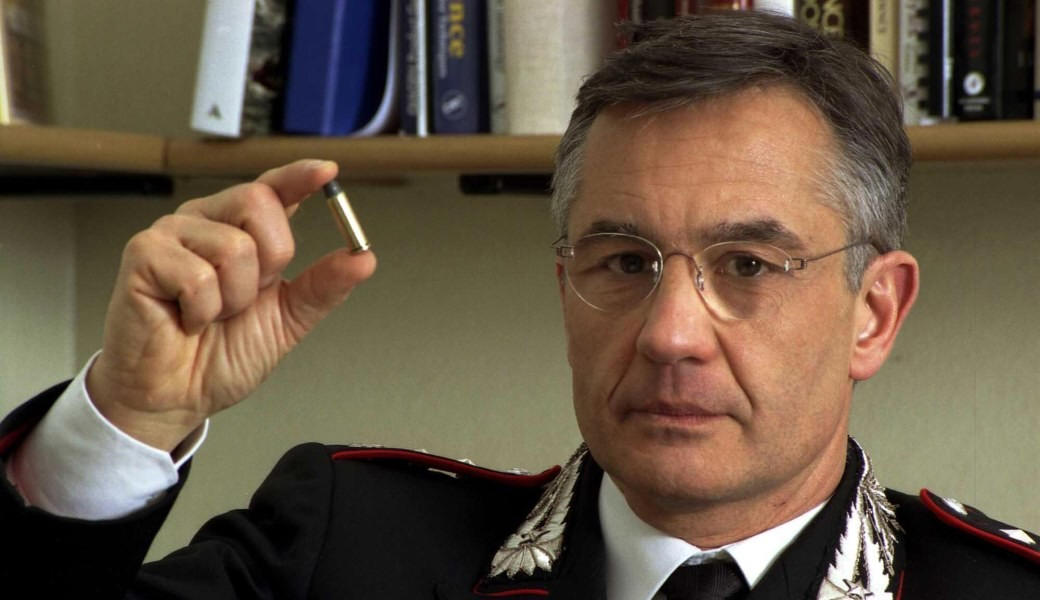
Luciano Garofano created Carabinieri DNA labs; quote below
Update On Pending RS And AK Appeal
Another of the many very informative reports that have appeared on the Seattle PI website.
A mild qualification up front is that we would have liked it mentioned that the prosecution have also initiated an appeal, to throw out the “mitigating circumstances” outlined in the Massei Report.
A reversal on the mitigating circumstances, which we too have always found problematical, could result in all three serving longer time. What the prosecution will come out with in that phase is a real sleeper in this appeal.
1. On John Kerchers article protesting the over-the-top PR campaign
The Kerchers have maintained their silence since their daughter’s murder, even as Knox’s parents appeared on national television in the United Kingdom, the U.S. and Italy. But that could change, as negotiations are under way with at least one national network to hear the Kerchers’ side of the story.
Correct and accurate. More on Meredith would be so welcome to an American audience. We reposted John Kercher’s hard-hitting article here in English and (as the Italian media mostly don’t yet know about it) here translated into Italian.
Biased reports like those of the ill-researched Nikki Batiste of ABC, which mis-stated and ridiculed John Kercher’s claims, omitted to say what Andrea Vogt says: this is THE FIRST TIME that John Kercher has gone public, in an attempt to stop the depraved multi-million-dollar deluge.
2. On the chances of an overturn of the December 2009 verdicts.
American pundits are quick to predict Knox could walk, but Italian legal experts say the chances of completely overturning her conviction aren’t good. More likely, they say, are the prospects of a sentence reduction.
“The Knox trial is one of the few, in the history of Italian criminal justice, in which over 25 judges have agreed—at different stages—on the adverse impact of the collected evidence against the positions of both Knox and Sollecito. In this respect, the case is rather unusual, as Italian justice is often characterised by conflicting decisions of courts on the same case,” said Stefano Maffei, an Oxford-educated professor of criminal law in Italy interviewed by seattlepi.com.
“What I can confirm is that courts of appeal are generally more lenient than courts of first instance, and I would not be surprised if the decision on appeal could bear a lower sentence for both defendants.”
The point is made up at the top here that this report does not mention the appeal of the prosecution for tougher sentences , which would seem to effectively balance out the probabilities that Mr Maffei and all the defenses now claim.
The sheer number of judges that all of them agreed on the evidence in this case is particularly damning. Our own Italian lawyers between them know of ZERO cases where so many judges in succession have found no reason to reverse any part of the process.
We have posted a number of good descriptions of how the Italian process actually works (these go beyond the descriptions in ANY British or American reporting, another sign of how sloppy it has mostly been), and our key posts can be seen here and here and here.
3. On the requested defense witness Mario Alessi
In a file tucked neatly under a polished glass paperweight in Laura Ferraboschi’s Parma law offices is a carefully guarded letter that Knox and Sollecito hope will set them free.
It is 10 pages, handwritten in the small, tilted script of Mario Alessi, a convicted murderer who had the prison cell across from Rudy Guede in the sex crimes ward of a tough prison just north of Rome….
Alessi mailed his statement to her for safekeeping after becoming concerned it might “disappear,” she said…. Sollecito’s lawyers, eager to have the letter at their disposition, asked Ferraboschi to share it, but she has refused, saying she did not feel it would be ethical to do so.
“Alessi sent the statement to me for protection, and I do not feel it is appropriate to give it to other lawyers who might drag him into a case that could negatively impact him,” Ferraboschi said. “If a judge requests the statement or his presence, then we will provide it.”
Good luck on that one. We doubt Alessi ever makes the stand. Here is our most recent post on Mario Alessi which links back to several that went before.
Prosecutors Mignini and Comodi also interviewed Alessi. They have not yet made public what he said.
Investigators and prison staff would have checked Alessi out very carefully. Laura Ferraboschi seems to be hanging firm on not sharing the letter, out of concern that Alessi could incure a charge of perjury.
4. On the requested defense witness Luciano Aviello
The second series of jailhouse “revelations” are from Luciano Aviello, a Mafia turncoat from Naples who shared a cell in Terni with Raffaele Sollecito. Knox’s lawyers went to videotape a statement from him in prison near Turin in March, a month after Bongiorno had videotaped Alessi’s statement in Viterbo.
He wrote several letters to the court last year. In the most recent statement, he claims he can prove all three people in jail for Kercher’s murder are innocent. It was his own brother, he says, who killed her. Aviello…
Aviello said his brother killed Kercher in a robbery gone awry, then asked Aviello to hide a bloody knife and set of house keys. Kercher’s set of house keys have not been found.
Good luck on that one too. We doubt that Aviello too ever makes the stand.
In our most recent post on him here we remarked that, with this guy, the defense was already seriously grasping at straws. We are amazed that they still want to wheel him out. That weak move does not bode well for Knox and Sollecito.
5. On the requests for more testing of the DNA
Repeatedly, judges have rejected defense arguments about the forensic evidence despite the slipshod way it was processed and Italy’s reputation of lagging behind the rest of Europe in DNA certification, handling protocols and databasing.
Many outside observers believe the court should allow for such an independent review, given the number of protocol mistakes revealed in the first trial.
Defense attorneys and their expert witnesses heavily criticized the work of police biologist Patrizia Stefanoni and the Perugia and Rome forensic teams working under her direction for such missteps as not changing gloves after picking up evidence, poor collection methods and incomplete records of how evidence was handled and in what exact order during later laboratory testing….
Two of the primary pieces of evidence against Knox and Sollecito are highly contested: A bra clasp originally catalogued in the first days after the murder that was picked up in a sweep of the crime scene 46 days later, and the kitchen knife with Knox’s DNA found on the handle and the victim’s DNA found on the blade. The bra clasp is said to contain Sollecito’s DNA. The amount of Kercher’s DNA found on the blade was such a trace amount it registered with a “too low” reading when analyzed.
Our DNA section on TJMK is very complete and to a very high standard. The three posts here and here and here are particularly worth a very careful read.
More tests had already been denied by Judge Massei. Defenses tend to like to do this, to keep insisting on more and more testing, until finally with luck an expert breaks their way.
The defense now “highly contests” the testing but they also attempted that throughout the trial and several of their experts under cross-examination had to take a step back.
Experts were invited to the one-time-only DNA testing of the knife and then (surprise, surprise) on the day of testing not all of them showed up.
And on whether Italy lags behind the rest of Europe on standards, see below (Italy doesn’t)..
6. On the standards of the laboratories that did the testing
A top geneticist at one of Europe’s top forensic labs at the University of Salzburg confirmed in an interview with seattlepi.com that it is possible to amplify such a small amount of DNA, as Stefanoni did, until DNA can be identified. But the expert added that it would not be allowable unless the result could be reproduced, something police biologist Stefanoni said under cross-examination could not be done.
The Salzburg geneticist, who does forensic testing for police agencies in neighboring Austria, said that in the university’s certified lab (which has the highest certification available in Germany and Austria) different operators are required to handle suspect and victim DNA and that the various phases of DNA analysis happen in different labs along a “one-way street” to avoid the possibility of contamination.
Such protocols were not in place in Rome. In fact, Italy is noted for being behind on international forensic standards. For example, it is one of the last (and only) European countries to have not yet become part of the Prum convention, which sets basic guidelines for sharing of DNA data and other security information.
The top geneticist at Salzburg University is unfortunately not named, presumably at his request, and there have been so many claims by both anonymous and unqualified self-proclaimed experts throughout this case that we wish he had said that yes, he could be named.
The Rome labs were in fact being operated to international standard and they had followed the European protocols for years. When they were only recently certified to European standards, none of the procedures or the training or the layout of the labs had to be changed.
Perhaps the top geneticist should have mentioned this.
7. And on the views of renowned forensic scientists Luciano Garofano
One of Italy’s top forensic biologists, retired Caribinieri General Luciano Garofano, is at the forefront of the push to introduce a national database and DNA certification standard in Italy. Garofano (a member of the American Academy of Forensic Sciences who collaborated frequently with the FBI over the years as a high-ranking Caribinieri military officer) analyzed the forensic evidence in the Perugia case for a book released shortly after the trial was complete.
He believes Knox was involved in the murder, but he disagreed with the court’s conclusion that Kercher was sexually assaulted—he is convinced Kercher’s death was a fight that degenerated, then later staged as a rape.
Interviewed by seattlepi.com, Garofano said his read of Knox’s appeal was that it was mostly a rehashing of “points that have already been debated…. The knife is a weak element . . . they could argue it should be thrown out because the amount of DNA does not meet international forensic standards. But that still leaves a lot of other evidence,” Garofano said.
“I do not believe there is enough there to convince an Italian magistrate and jury to overturn this conviction.”
Terrific comments. Hard to see why either Knox or Sollecito deserve even the slightest reduction of their sentence. Neither of them has come up with a consistent explanation, both of them seem to have shown some glee, and neither has shown the slightest sign of repentance.
If they tortured and killed Meredith in a particularly cruel and barbaric way, as it seems, then they both seriously need to serve the time.

